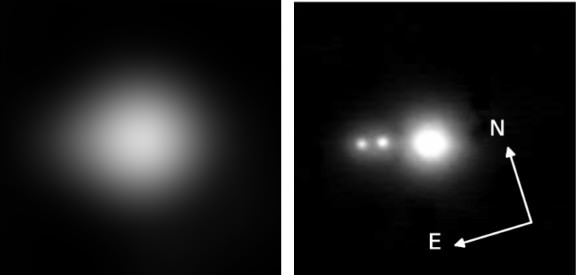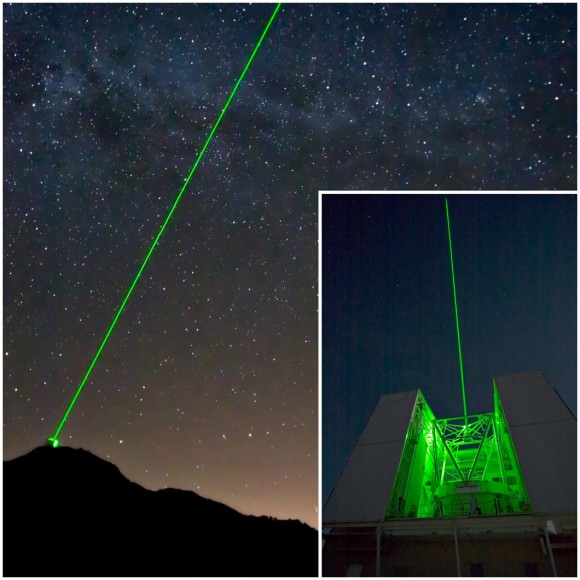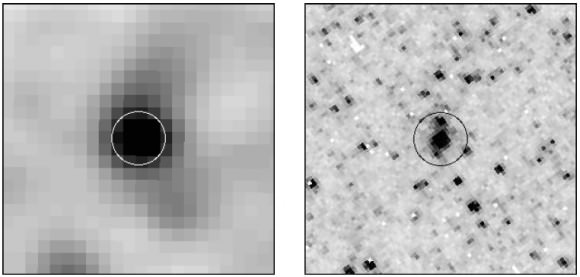Observations by the Kepler satellite have advanced our knowledge of stars and their orbiting planets, yielding more than 100 confirmed planets and about 3,000 candidates. However, orbiting planets may not be the source for a fraction of those detections.
“There are many things in the sky that can produce transit-like signals that are not planets, and thus we must be sure to identify what really is a planet detected by Kepler,” Stephen Bryson told Universe Today. NASA Ames Research Center scientists Bryson and Jon Jenkins (also at the SETI Institute) are the lead authors on a new paper that aims to identify pseudo-planets detected by Kepler.
Small eclipses present in Kepler brightness measurements for a star (a lightcurve) may be indicative of an orbiting planet blocking light from its host star (see image below). However, under certain circumstances binary stars can mimic that signature.
Consider a Kepler target that is actually a chance superposition of a bright star and a fainter eclipsing binary system, whereby the objects lie at different distances along the sight-line. The figure below illustrates that their combined light can produce a lightcurve that is similar to a transiting planet. The bright foreground star dilutes the typically large eclipses produced by the binary system.

“Most of the time these eclipsing binaries are not exactly aligned with our target star,” Bryson added, “and we can carefully examine the pixels to discover that the location of the transit signal is not the target star.” The team developed algorithms to identify pseudo-planets when the stars are individually resolved. Tagging spurious planet detections is important since there are numerous candidates, and yet limited observing time for follow-up efforts.
The team has been refining those algorithms as knowledge of the satellite’s in situ behavior increases. “These algorithms have been developed and used over the last four years. Some details of the techniques in the paper are new and will appear in future versions of the Kepler [software processing] pipeline,” said Bryson.
However, if multiple stars fall within the same pixel they are not individually resolved by Kepler, and a separate approach is required to infer their presence. Consider the example highlighted in the image below, where several stars were unresolved by Kepler yet appear in higher resolution images. The matter is exacerbated in part because Kepler’s spatial resolution is not optimal, and thus multiple stars may be confused as a single object. By contrast, certain ground-based telescopes can achieve ~20 times Kepler’s spatial resolution when adaptive optics are implemented.

Adams et al. 2012 obtained high-resolution images of 90 Kepler targets, one of which is highlighted above. That team noted that, “Close companions … are of particular concern … Of the [90 Kepler targets surveyed] 20% have at least one companion within [half a Kepler pixel].” The high-resolution images were acquired via the MMT observatory (shown below) and the Palomar Hale-200-inch telescope.
Obviously, the resolution problem becomes more acute when observing rich stellar fields (high densities), such as near the plane of our Galaxy.
“Background eclipsing binaries account for as many as 35% of all planet-like transit signals when we are looking near the Milky Way, because there are many stars in the background,” Bryson told Universe Today. “When we look away from the Milky Way the fraction of background eclipsing binaries falls to about 10% of all planet-like transit signals because there are far fewer background stars of all types.”
However, regarding Kepler’s coarser resolution Bryson underscored that, “[it is] expected with such a large field telescope.” Kepler’s large field is certainly advantageous, as it permits the satellite to monitor 100,000+ stars over more than 100 square degrees of field.

Radial velocity measurements are an ideal means for evaluating planet candidates (and to help yield the mass). The data are pertinent since velocity shifts occur in the spectrum of the host star owing to the planet’s gravity. However, Adams et al. 2012 note that “Many of these objects do not have … radial velocity measurements because of the amount of observing time required, particularly for small planets around relatively faint stars. Another method is needed to confirm these types of planets … High-resolution images are thus a crucial component of any transit follow-up program.”
Identifying unresolved stars is crucial for yet another reason. Note that the fundamental parameters determined for a transiting planet depend in part on the fraction of the host star’s light that is obscured (the eclipse depth). However, if multiple unresolved stars exist they will contribute to the overall brightness, and hence the observed planet eclipse will be diluted and underestimated (see figure 2, above). Indeed, Adams et al. 2012 note that, “Corrections to the planetary parameters based on nearby [contaminating] stars can range from a few to tens of percents, making high resolution images an important tool to understanding the true sizes of other discovered worlds.”
The case of K00098 is a prime example underscoring the importance of identifying unresolved contaminating stars. K00098 features two rather bright stars that were unresolved and unknown prior to the acquisition of high-resolution images. Consequently, previously determined parameters for that star’s transiting planet were incorrect. Concerning K00098, Adams et al. 2012 remarked that, “for K00098, the dilution [of the eclipse depth] … were substantial: the [planet’s] radius increased by 10%, the mass by 60% … and the density changed by 25% [from that published]. Without high resolution images, we would have had a very inaccurate picture of this planet.”

Incidentally, unaccounted for light from unresolved stars isn’t merely a problem for exoplanet studies. The issue is rather pertinent when researching the cosmic distance scale and the Hubble constant (expansion rate of the Universe). Consider the images above which feature the same field in M33. The image exhibited on the left is from a ground-based facility, whereas the higher-resolution image displayed on the right is from the Hubble Space Telescope (HST). The brightest star at the center of the image is a Cepheid variable star, which is a pulsating star that is used to establish distances to galaxies. In turn those distances are subsequently employed to determine the Hubble constant. The HST image reveals stars that are unresolved in the ground-based image, and thus the distance inferred from that observation is compromised since the Cepheid appears (spuriously) brighter than it should be.
“Blending [e.g., added light caused by unresolved stars] leads to systematically low distances to galaxies observed with the HST, and therefore to systematically high estimates of the Hubble constant,” remarked Mochejska et al. 2004. However, there is an ongoing debate concerning the importance of such an effect (Ferrarese et al. 2000, Mochejska et al. 2001).
In sum, numerous groups are developing methods to identify pseudo-planets in the Kepler database. Given the large sample and sizable investment of time required to confirm a planet candidate: such efforts are important (e.g., Bryson et al. 2013). Data from the Kepler mission have helped advance our understanding of stars and their orbiting planets, and more is yet to come. If you’d like to help the Kepler team identify planets around other stars: join the Planet Hunters citizen science project.
The Bryson et al. 2013 findings have been submitted to PASP for peer review, and a preprint is available on arXiv. The coauthors on the study are J. Jenkins, R. Gilliland, J. Twicken, B. Clarke, J. Rowe, D. Caldwell, N. Batalha, F. Mullally, M. Haas, and P. Tenenbaum. The interested reader desiring additional information will find the following pertinent: Adams et al. 2012, Collier Cameron 2012 (e.g., for other scenarios that can mimic the lightcurve of a transiting-planet), “Strange New Worlds: The Search for Alien Planets and Life beyond Our Solar System” by Ray Jayawardhana, “Distant Wanderers: The Search for Planets Beyond the Solar System” by Bruce Dorminey. For discussion on how light from unresolved sources affects the cosmic distance scale see Mochejska et al. 2004 (and for the opposite point of view, and subsequent rebuttal: Ferrarese et al. 2000, Mochejska et al. 2001).


Always amazing
Excellent article. Clear and informative.
This is a good example of how science is about isolating different variables in order to understand phenomena and to distinguish between different processes.
LC